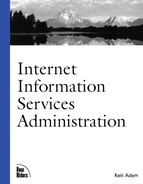SMTP Site Properties
The SMTP site property sheet is used to set connection parameters for identification, connections, and logging configuration for a site from which you need to send mail with the Microsoft SMTP service. The parameters include identifying the correct port to be used, designating the number of connections that can be opened simultaneously, limiting the length of time before a connection remains open, and enabling or disabling logging for each site.
General Properties
The General tab of the SMTP site property sheet is fairly self-explanatory for configuration. Through this site, you designate the SMTP site identification via a description and an IP address.
To configure incoming and outgoing connections, you must identify the TCP/IP port used for the connections, as well as designate connection timeouts and connection limitations on a per-domain basis. All these options have a set default. You'll need to specify an IP address, unless you have only one SMTP virtual server, but I recommend that you use the default port 25. In addition to providing identification and connection information, this interface allows you to enable logging for the SMTP site and to choose your log file format. For more information on log file formats, see Chapter 12, "Managing Log Files." From this tab, you can also choose properties that specifically define timelines for creating new logs and defining file directories for the logs.
Access
The Access tab enables you to configure the following information:
Access control. Configure authentication methods for accessing the SMTP virtual server. For information on authentication methods, look back at Chapter 4, "IIS Security."
Secure communication. Configure the use of certificates for Secure Sockets Layer (SSL) communication. For information on SSL and certificates, see Chapter 9, "SSL and Certificate Services."
Connection control. Grant or deny access to this virtual server based on IP address and domain name restrictions. For information on configuring this, review Chapter 4.
Relay restrictions. This option enables you to control domains that send email through this SMTP virtual server. For example, if I configure an SMTP virtual server for kadam.com, I don't want a user making up a sender address and using my SMTP server to originate his email. Most users who do this do not have the best intentions, so it is important to restrict this type of use.
Messages
Within this property sheet, you can set limits for messages, including the size and the number of recipients that can receive the message. For example, if a message is sent that exceeds the limits that are set, the message will become undeliverable and will be returned to the sender along with a non-delivery-report (NDR). If the NDR proves to be undeliverable as well, the message is sent to the Badmail directory. The Badmail directory, as well as the storage for NDRs and bad mail, is defined on this property sheet.
Other properties defined within this sheet include limiting the number of outbound messages per connection and the number of recipients per message. In addition, receiving parties of an NDR generated by Microsoft SMTP Service can be configured on this sheet.
Delivery
The configuration of your delivery options is divided into outbound and local delivery. The default for these options is fine, unless you have a specific requirement. Some of the options include retry intervals, delay notifications, and expiration timeouts.
Advanced options include defining the maximum hop count, the fully qualified domain name (the address used in the message exchanger [MX] record in your DNS server), and the smart host or server that all outgoing messages are routed through.
LDAP Routing
Lightweight Directory Access Protocol (LDAP) routing enables you to specify a directory services server with which the SMTP virtual server can communicate by using LDAP. An LDAP server stores information about mail clients and can resolve senders and recipients. LDAP routing is an excellent way to integrate Windows 2000 Active Directory users into mailing lists. It can also be used to integrate user information from both the site server membership directory and Microsoft Exchange.
Security
The Security tab is similar to the Operators tab in the WWW properties sheet. Use this tab to give specific user accounts permission as operators for this SMTP virtual server. However, as with WWW sites, there is little need to add operators, so you should not have to configure this tab.
